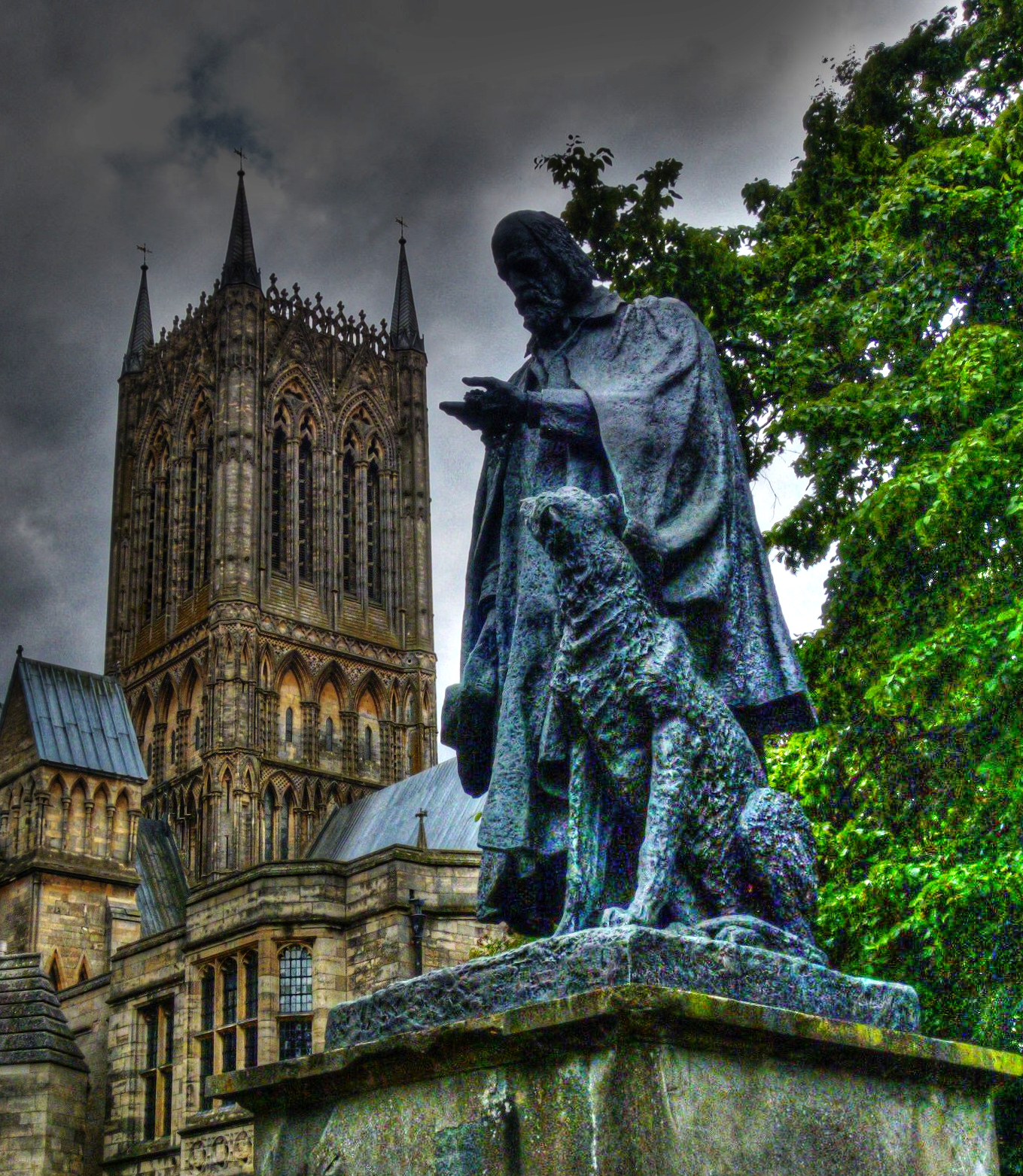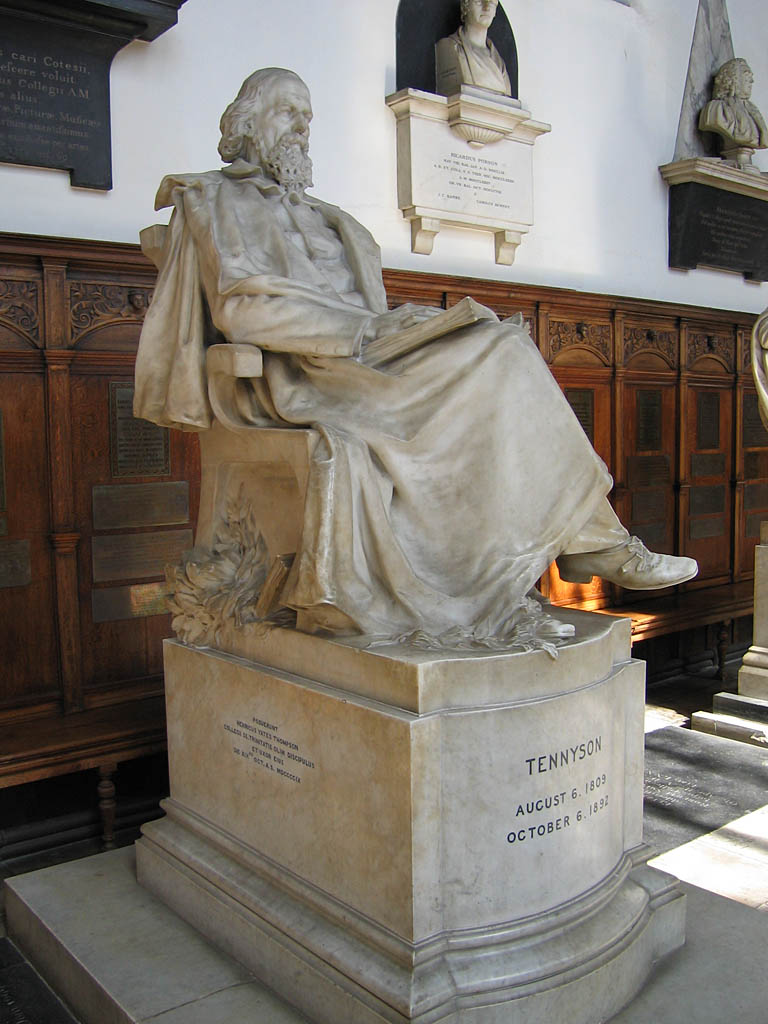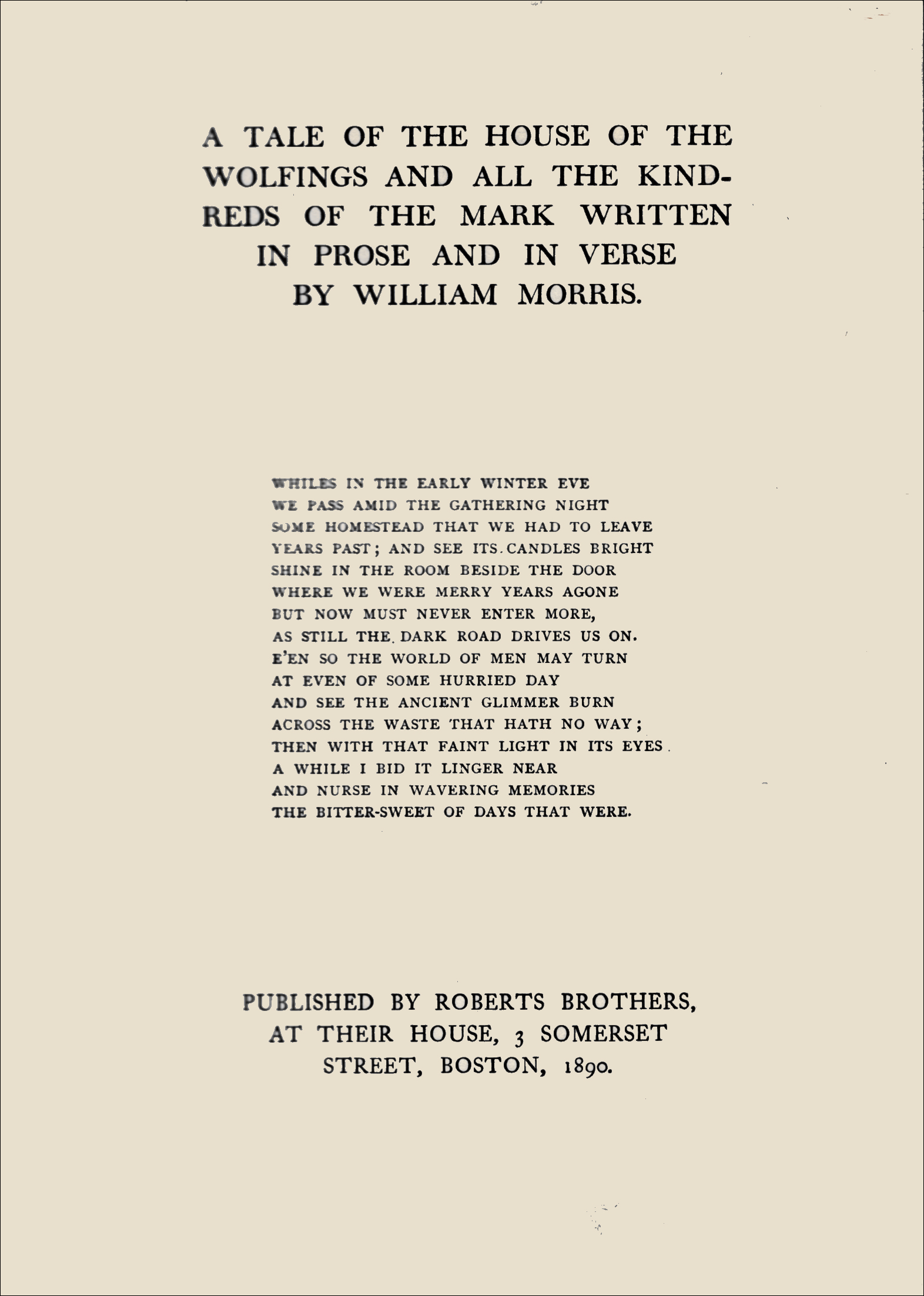|
Flower In The Crannied Wall
"Flower in the Crannied Wall" is a poem composed by Alfred Tennyson in 1863 beside the wishing well at Waggoners Wells. The poem uses the image of a flowering plant - specifically that of a chasmophyte rooted in the wall of the wishing well - as a source of inspiration for mystical/metaphysical speculation and is one of multiple poems where Tennyson touches upon the topic of the relationships between God, nature, and human life. The Tennyson memorial statue was completed in 1903 by George Frederic Watts and unveiled in 1905 at Lincoln Cathedral, shows Tennyson holding a flower in his hand standing alongside a dog. Underneath, on the pedestal of the statue, lies a plaque of the poem. Since the statue was unveiled in 1905, there has been concerns over discoloration and disintegration. A commissioned firm specializing in bronze restoration then expressed its view that the statue appears similar to when it was first unveiled. Text Flower in the crannied wall, I pluck you out of ... [...More Info...] [...Related Items...] OR: [Wikipedia] [Google] [Baidu] |
Tennyson Lincoln HDR
Alfred Tennyson, 1st Baron Tennyson (6 August 1809 – 6 October 1892) was an English poet. He was the Poet Laureate during much of Queen Victoria's reign. In 1829, Tennyson was awarded the Chancellor's Gold Medal at Cambridge for one of his first pieces, "Timbuktu". He published his first solo collection of poems, ''Poems, Chiefly Lyrical'', in 1830. "Claribel" and "Mariana", which remain some of Tennyson's most celebrated poems, were included in this volume. Although described by some critics as overly sentimental, his verse soon proved popular and brought Tennyson to the attention of well-known writers of the day, including Samuel Taylor Coleridge. Tennyson's early poetry, with its medievalism and powerful visual imagery, was a major influence on the Pre-Raphaelite Brotherhood. Tennyson also excelled at short lyrics, such as "Break, Break, Break", "The Charge of the Light Brigade", "Tears, Idle Tears", and "Crossing the Bar". Much of his verse was based on classical mythol ... [...More Info...] [...Related Items...] OR: [Wikipedia] [Google] [Baidu] |
Auguries Of Innocence
"Auguries of Innocence" is a poem by William Blake, from a notebook of his now known as the Pickering Manuscript.Encyclopædia Britannica Online.The Pickering Manuscript" Online. Accessed 13 December 2010. It is assumed to have been written in 1803, but was not published until 1863 in the companion volume to Alexander Gilchrist's biography of Blake. The poem contains a series of paradoxes which speak of innocence juxtaposed with evil and corruption. It consists of 132 lines and has been published with and without breaks dividing it into stanzas. An augury is a sign or omen. The poem begins: It continues with a catalogue of moralising couplets, such as: and: The following lines are quoted in the film ''Dead Man ''Dead Man'' is a 1995 American acid western film written and directed by Jim Jarmusch. It stars Johnny Depp, Gary Farmer, Billy Bob Thornton, Iggy Pop, Crispin Glover, John Hurt, Michael Wincott, Lance Henriksen, Gabriel Byrne, Mili ...'' and in Agat ... [...More Info...] [...Related Items...] OR: [Wikipedia] [Google] [Baidu] |
Albert Francis Blakeslee
Albert Francis Blakeslee (November 9, 1874 – November 16, 1954) was an American botanist. He is best known for his research on the poisonous jimsonweed plant and the sexuality of fungi. He was the brother of the Far East scholar George Hubbard Blakeslee. Early life and education Albert Francis Blakeslee was born on November 9, 1874 in Geneseo, New York, to Augusta Miranda Hubbard Blakeslee and Francis Durbin Blakeslee, a Methodist minister. Blakeslee attended Wesleyan University, graduating in 1896. At Wesleyan, Blakeslee played several sports and won academic prizes in mathematics and chemistry. He received a master's degree from Harvard University in 1900 and a doctorate in 1904. He also studied at the University of Halle-Wittenberg in Germany from 1904 to 1906. ''Datura'', jimsonweed, research Blakeslee used the jimsonweed plant as a model organism for his genetic research. His experiments included using colchicine to achieve an increase in the number of chromosomes, whic ... [...More Info...] [...Related Items...] OR: [Wikipedia] [Google] [Baidu] |
Solanaceae
The Solanaceae , or nightshades, are a family of flowering plants that ranges from annual and perennial herbs to vines, lianas, epiphytes, shrubs, and trees, and includes a number of agricultural crops, medicinal plants, spices, weeds, and ornamentals. Many members of the family contain potent alkaloids, and some are highly toxic, but many—including tomatoes, potatoes, eggplant, bell and chili peppers—are used as food. The family belongs to the order Solanales, in the asterid group and class Magnoliopsida ( dicotyledons). The Solanaceae consists of about 98 genera and some 2,700 species, with a great diversity of habitats, morphology and ecology. The name Solanaceae derives from the genus ''Solanum''. The etymology of the Latin word is unclear. The name may come from a perceived resemblance of certain solanaceous flowers to the sun and its rays. At least one species of ''Solanum'' is known as the "sunberry". Alternatively, the name could originate from the Latin verb ''sol ... [...More Info...] [...Related Items...] OR: [Wikipedia] [Google] [Baidu] |
Entheogen
Entheogens are psychoactive substances that induce alterations in perception, mood (psychology), mood, consciousness, cognition, or behavior for the purposes of engendering spiritual development or otherwiseRätsch, Christian, ''The Encyclopedia of Psychoactive Plants: Ethnopharmacology and Its Applications'' pub. Park Street Press 2005 in sacred contexts. Anthropological study has established that entheogens are used for religion, religious, Magic (supernatural), magical, shamanism, shamanic, or spirituality, spiritual purposes in many parts of the world. Entheogens have traditionally been used to supplement many diverse practices geared towards achieving Transcendence (religion), transcendence, including divination, meditation, yoga, sensory deprivation, healings, asceticism, prayer, trance, rituals, chanting, Imitation of sounds in shamanism, imitation of sounds, hymns like peyote songs, Drum circle, drumming, and ecstatic dance. The Psychedelic drug, psychedelic experience ... [...More Info...] [...Related Items...] OR: [Wikipedia] [Google] [Baidu] |
Datura
''Datura'' is a genus of nine species of highly poisonous, vespertine-flowering plants belonging to the nightshade family Solanaceae. They are commonly known as thornapples or jimsonweeds, but are also known as devil's trumpets (not to be confused with angel's trumpets, which are placed in the closely related genus ''Brugmansia''). Other English common names include moonflower, devil's weed, and hell's bells. All species of ''Datura'' are extremely poisonous and potentially psychoactive, especially their seeds and flowers, which can cause respiratory depression, arrhythmias, fever, delirium, hallucinations, anticholinergic syndrome, psychosis, and even death if taken internally. Due to their effects and symptoms, they have occasionally been used not only as poisons, but also as hallucinogens by various groups throughout history. Traditionally, psychoactive administration of ''Datura'' species has often been associated with witchcraft and sorcery or similar practices in man ... [...More Info...] [...Related Items...] OR: [Wikipedia] [Google] [Baidu] |
Epigraph (literature)
In literature, an epigraph is a phrase, quotation, or poem that is set at the beginning of a document, monograph or section thereof. The epigraph may serve as a preface to the work; as a summary; as a counter-example; or as a link from the work to a wider literary canon, with the purpose of either inviting comparison or enlisting a conventional context. A book may have an overall epigraphy that is part of the front matter, or one for each chapter. Examples * As the epigraph to '' The Sum of All Fears'', Tom Clancy quotes Winston Churchill in the context of thermonuclear war:Why, you may take the most gallant sailor, the most intrepid airman or the most audacious soldier, put them at a table together – what do you get? The sum of their fears. * The long quotation from Dante's ''Inferno'' that prefaces T. S. Eliot's "The Love Song of J. Alfred Prufrock" is part of a speech by one of the damned in Dante's Hell. * The epigraph to E. L. Doctorow's ''Ragtime'' quotes Scott Joplin' ... [...More Info...] [...Related Items...] OR: [Wikipedia] [Google] [Baidu] |
Sophia A
Sophia means "wisdom" in Greek. It may refer to: *Sophia (wisdom) *Sophia (Gnosticism) *Sophia (given name) Places *Niulakita or Sophia, an island of Tuvalu *Sophia, Georgetown, a ward of Georgetown, Guyana *Sophia, North Carolina, an unincorporated community in Randolph County *Sophia, West Virginia *Sofia, Bulgaria, the capital and largest city of Bulgaria Arts, entertainment and media Books and publications * ''Sophia'' (journal), a periodical about religious and theological philosophy * ''Sophia'' (novel) by Charlotte Lennox (1762) Music *Sophia (British band) *Sophia (Japanese band) * Sophia (singer) or Sophia Abrahão, pop singer from Brazil * ''Sophia'' (The Crüxshadows EP) * ''Sophia'' (Sophia Abrahão EP) * "Sophia" (Nerina Pallot song) * "Sophia" (Laura Marling song) *"Sophia", a song by Good Shoes from '' Think Before You Speak'' *"Sophia", a song by Laura Nyro from ''Mother's Spiritual'' *"Sophia", a song by Six Organs of Admittance from ''Dust and Chimes'' Other ... [...More Info...] [...Related Items...] OR: [Wikipedia] [Google] [Baidu] |
Frederic W
Frederic may refer to: Places United States * Frederic, Wisconsin, a village in Polk County * Frederic Township, Michigan, a township in Crawford County ** Frederic, Michigan, an unincorporated community Other uses * Frederic (band), a Japanese rock band * Frederic (given name), a given name (including a list of people and characters with the name) * Hurricane Frederic, a hurricane that hit the U.S. Gulf Coast in 1979 * Trent Frederic, American ice hockey player See also * Frédéric * Frederick (other) * Fredrik * Fryderyk (other) {{disambiguation, geo ... [...More Info...] [...Related Items...] OR: [Wikipedia] [Google] [Baidu] |
Theodore Watts-Dunton
Theodore Watts-Dunton (12 October 1832 – 6 June 1914), from St Ives, Huntingdonshire, was an English poetry critic with major periodicals, and himself a poet. He is remembered particularly as the friend and minder of Algernon Charles Swinburne, whom he rescued from alcoholism and drug use and persuaded to continue writing. Birth and education Walter Theodore Watts was born at St Ives, in what was then Huntingdonshire. He added his mother's name Dunton to his surname in 1897. He was originally educated as a naturalist, and saw much of the East Anglian Gypsies, of whose superstitions and folklore he made careful study. Abandoning natural history for the law, he qualified as a solicitor and went to London, where he practised for some years, giving his spare time to his chosen pursuit of literature. One of his clients was Swinburne, whom he befriended in 1872. Literary contributions Watts-Dunton contributed regularly to the ''Examiner'' from 1874 and to the ''Athenaeum'' from ... [...More Info...] [...Related Items...] OR: [Wikipedia] [Google] [Baidu] |
Eternity
Eternity, in common parlance, means Infinity, infinite time that never ends or the quality, condition, or fact of being everlasting or eternal. Classical philosophy, however, defines eternity as what is timeless or exists outside time, whereas sempiternity corresponds to infinite Duration (philosophy), duration. Philosophy Classical philosophy defines eternity as what exists outside time, as in describing timeless supernatural beings and forces, distinguished from sempiternity which corresponds to infinite time, as described in requiem prayers for the dead. Some thinkers, such as Aristotle, suggest the Eternity of the world, eternity of the natural cosmos in regard to both past and future eternal duration. Boethius defined eternity as "simultaneously full and perfect possession of interminable life". Thomas Aquinas believed that God's eternity does not cease, as it is without either a beginning or an end; the concept of eternity is of divine simplicity, thus incapable of be ... [...More Info...] [...Related Items...] OR: [Wikipedia] [Google] [Baidu] |
Infinity
Infinity is that which is boundless, endless, or larger than any natural number. It is often denoted by the infinity symbol . Since the time of the ancient Greeks, the philosophical nature of infinity was the subject of many discussions among philosophers. In the 17th century, with the introduction of the infinity symbol and the infinitesimal calculus, mathematicians began to work with infinite series and what some mathematicians (including l'Hôpital and Bernoulli) regarded as infinitely small quantities, but infinity continued to be associated with endless processes. As mathematicians struggled with the foundation of calculus, it remained unclear whether infinity could be considered as a number or magnitude and, if so, how this could be done. At the end of the 19th century, Georg Cantor enlarged the mathematical study of infinity by studying infinite sets and infinite numbers, showing that they can be of various sizes. For example, if a line is viewed as the set of all o ... [...More Info...] [...Related Items...] OR: [Wikipedia] [Google] [Baidu] |







